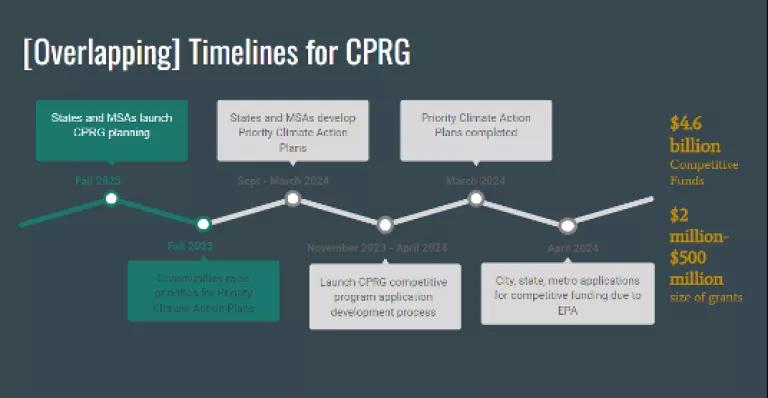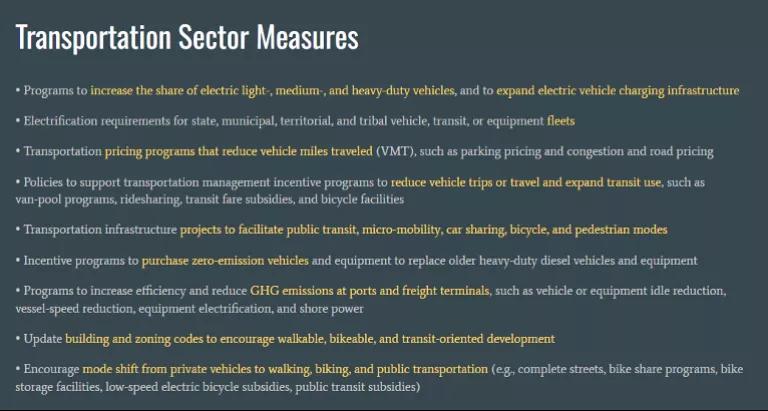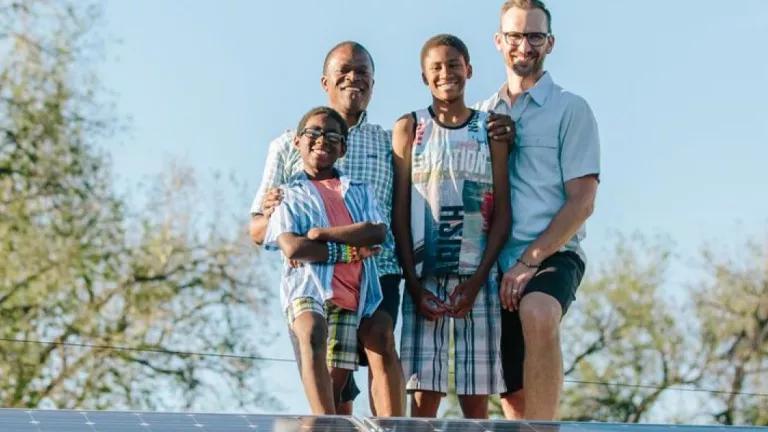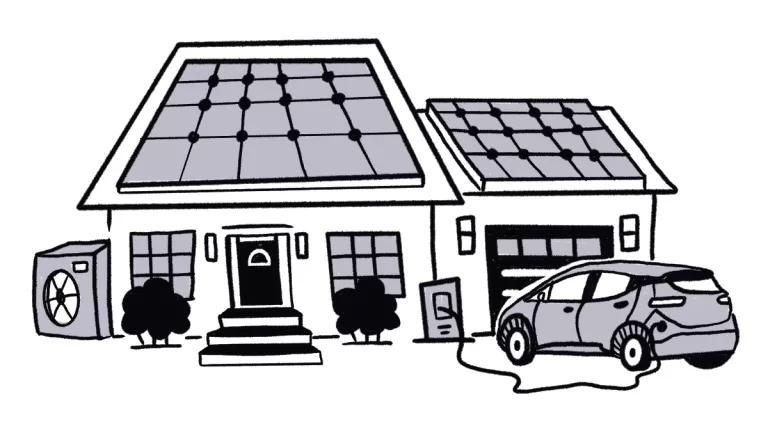Climate Pollution Reduction Grants (CPRG)
A funding pathway for equitable and sustainable transportation projects

Traffic and pedestrians on a tree-lined street in New York City
Lance Cheung/USDA
The Inflation Reduction Act (IRA), one of the largest climate investment bills in U.S. history, is channeling large amounts of federal dollars into the transportation sector; so much, in fact, that it can be challenging to keep track of new federal grant opportunities.
One often-overlooked initiative is the $5 billion Climate Pollution Reduction Grants (CPRG) program, which aims to reduce greenhouse gas (GHG) emissions through investments in transportation, food waste, and renewable energy. Administered by the U.S. Environmental Protection Agency (EPA), the program brings disadvantaged communities together with state and local governments to create GHG reduction projects that are tailored to local contexts.
The CPRG follows two overlapping stages. In the first stage, the EPA awards $250 million in planning grants to states, large metro areas, tribes, and territories, in which each recipient receives $1 to $3 million to create Priority Climate Action Plans (PCAPs). These plans will show how state and local priorities can help achieve GHG reductions and benefit communities.
As PCAPS are submitted, the EPA will award a total of $4.6 billion in implementation grants to put them into action. Eligible entities for these grants include states, territorial agencies, municipalities, and air pollution control agencies, as well as tribes and tribal consortia.
Figure 1: CPRG timeline

NRDC
Status of the CPRG
Money for the planning grants is already out the door, with 46 states applying to receive funds. States and metropolitan areas are currently creating PCAPs, which are due March 1, 2024. For tribes and territories, these plans are due April 1, 2024.
On September 20, 2023, the EPA opened a competition for the implementation grants. Applications are due before April 1, 2024. Out of the total $4.6 billion, $300 million was earmarked exclusively for tribes and territories, with submissions due May 1, 2024. This means that any eligible group—including states, metropolitan areas, tribes, and territories—with a proposed project can apply within the next six months to receive implementation funding.
How can CPRG funds work for equitable transportation?
The CPRG offers billions of dollars to projects that reduce GHG using various measures. The program also presents a unique opportunity to promote equitable and sustainable transportation projects for several reasons:
- Transportation projects with equitable and sustainable outcomes are likely to receive funds. The CPRG is a new program, but one thing is clear: The EPA’s priority is to provide clean air to the public. Transportation is the single-largest contributor to U.S. GHG emissions and a major source of localized air pollution; therefore, projects in this sector are extremely likely to secure funds.
Here are a few examples of transportation sector measures provided by the EPA:
Figure 2: Example of transportation measures provided by the EPA

EPA
For transportation projects, the CPRG grants cover both vehicle electrification and non-car alternatives, such as public transit, walking, and biking. Electric vehicles (EVs) do not contribute to on-road GHG emissions because they produce zero tailpipe emissions. This has knock-on benefits for public health, especially for low-income people of color, who are more likely to live in high-pollution areas than other socioeconomic groups.
Non-car alternative projects—including public transit, walking, and biking—help communities reduce the number of single-occupancy vehicles on the road. Fewer cars mean cleaner air. But the benefits go beyond just clean air. By expanding transportation choices, we're making sure that everyone, especially underserved communities, can get around easily and affordably.
The CPRG is casting a wide net when it comes to funding transportation projects, which means there is flexibility to implement funds based on the needs and challenges of local contexts.
2. Funds from CPRG can complement other transportation funding sources. The EPA encourages the use of supplemental funding from other federal sources, such as the Infrastructure Investment and Jobs Act (IIJA), to maximize GHG reductions and community benefits. Since half of the IIJA funds are dedicated to transportation investments, funding from both the CPRG and IIJA can work in tandem. For example, IIJA grant programs administered by the U.S. Department of Transportation (DOT)—such as the Neighborhood Access and Equity Grant Program and the Rebuilding American Infrastructure with Sustainability and Equity program—are well suited to providing complementary funding for projects focused on non-car alternatives. Other programs, like the Charging and Fueling Infrastructure grant and the National Electric Vehicle Infrastructure program, could complement electrification projects. Pooling funds from multiple sources not only increases resources available for equitable and sustainable transportation initiatives but also amplifies their impact and reach.
3. The CPRG program is an opportunity to advance community-driven transportation solutions. The EPA is requiring CPRG grant recipients for both planning and implementation grants to meaningfully engage with communities, as reflected in their application guidelines. Projects are evaluated on the tangible benefits they offer to low-income and disadvantaged communities. The CPRG is also part of the Biden administration’s Justice40 Initiative, which requires 40 percent of benefits from federal investments to go toward these communities.
Historically, the concerns of underserved communities have been an afterthought in transportation planning. The CPRG represents an opportunity to address and identify workable solutions for long-standing injustices that have hurt disadvantaged areas as well as the climate. Community involvement is the key to ensuring sustainable transportation projects are successful in the long term because community members provide local knowledge, support, and lived experiences, helping to minimize local disputes and opposition. As a result, both the DOT and EPA have published resources on community engagement.
The CPRG has the potential to create transformative opportunities to redefine transportation through an equitable and sustainable lens. The program clearly demonstrates that community development and climate solutions go hand in hand.



